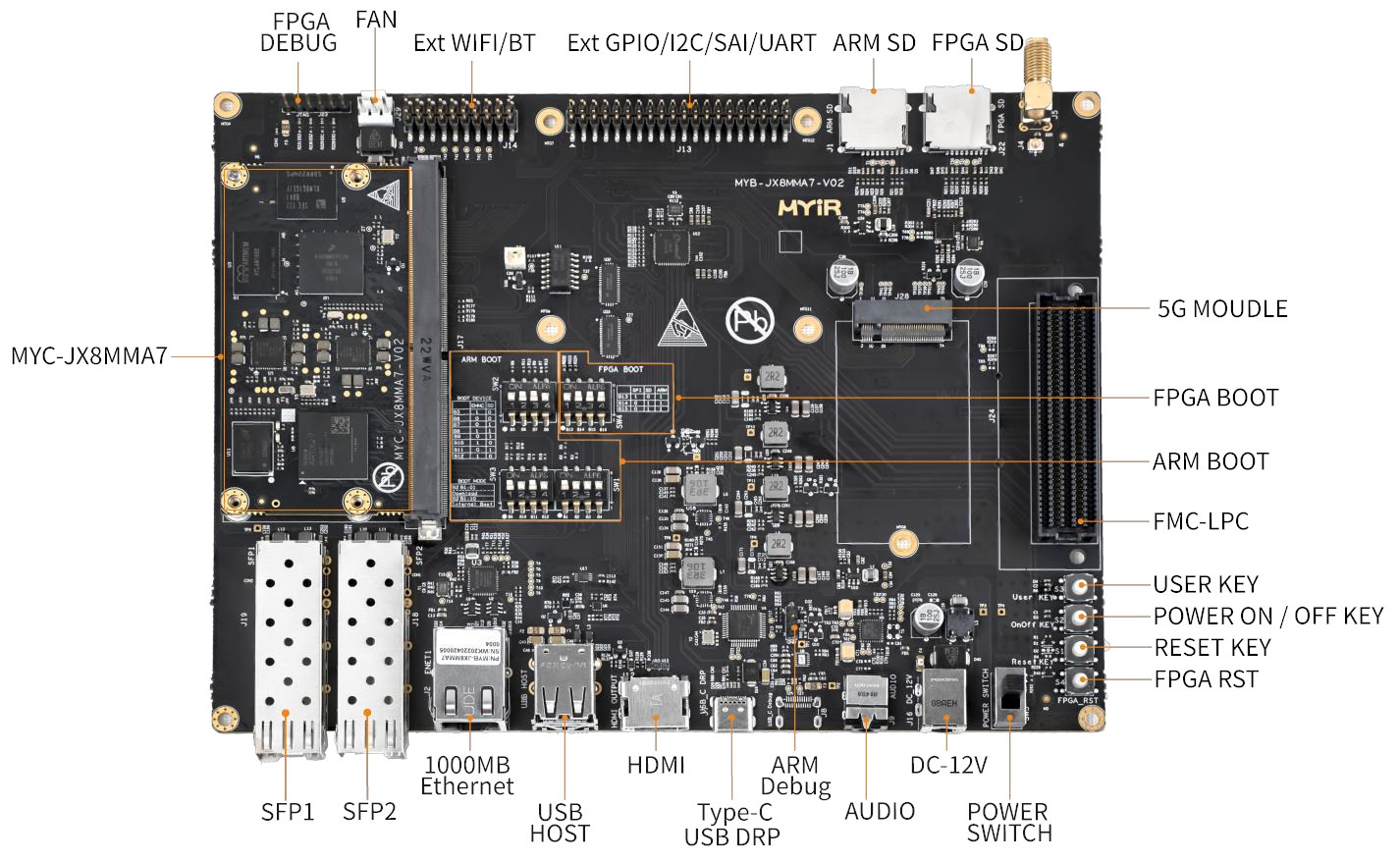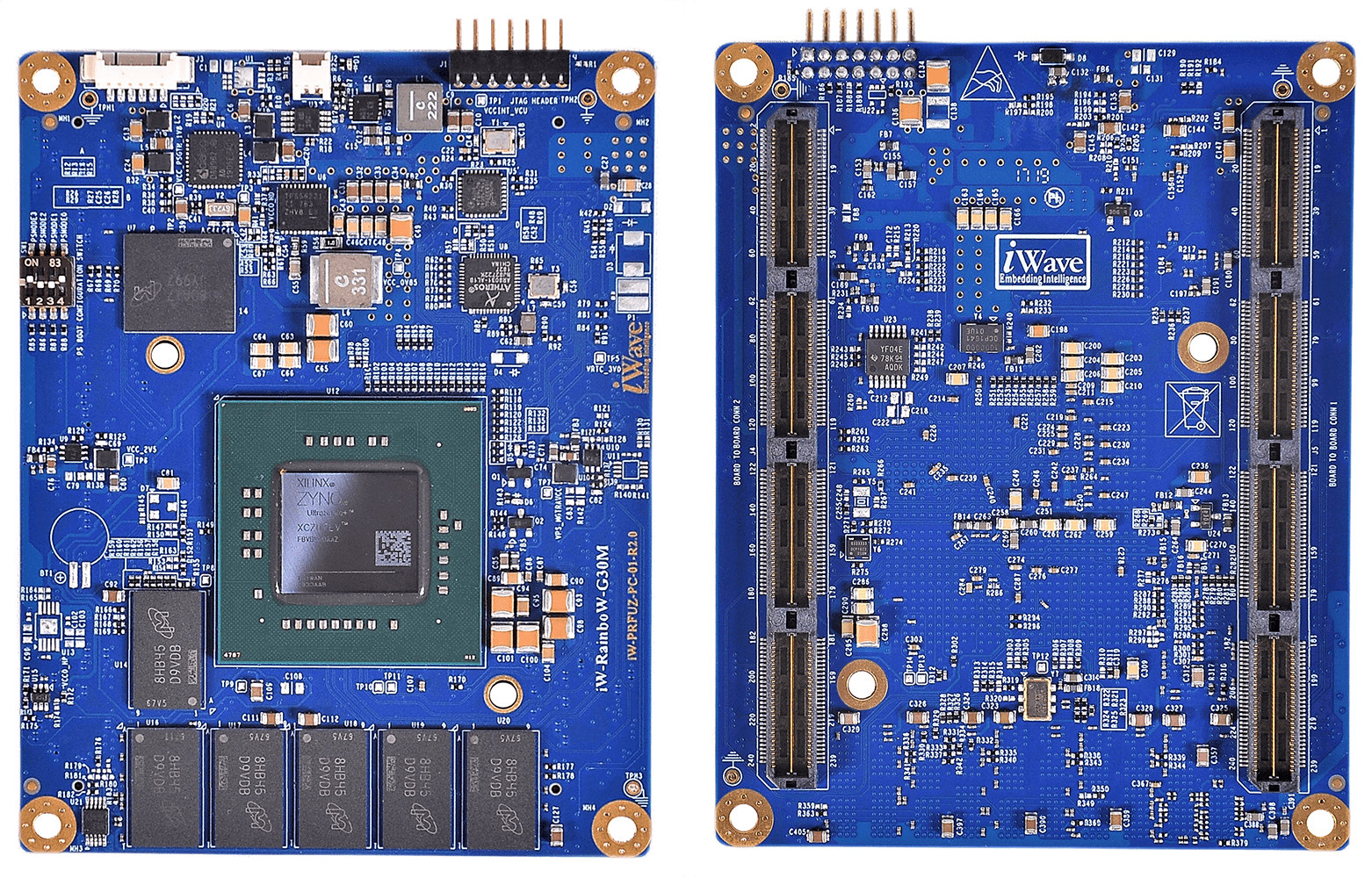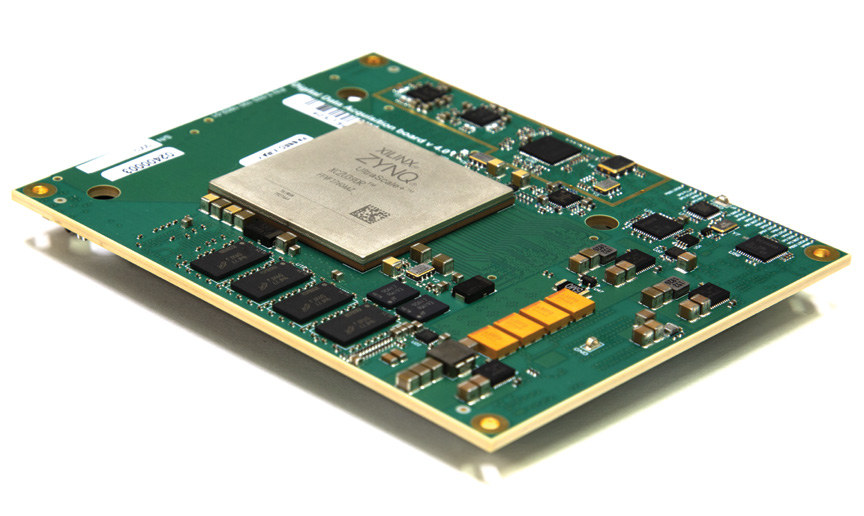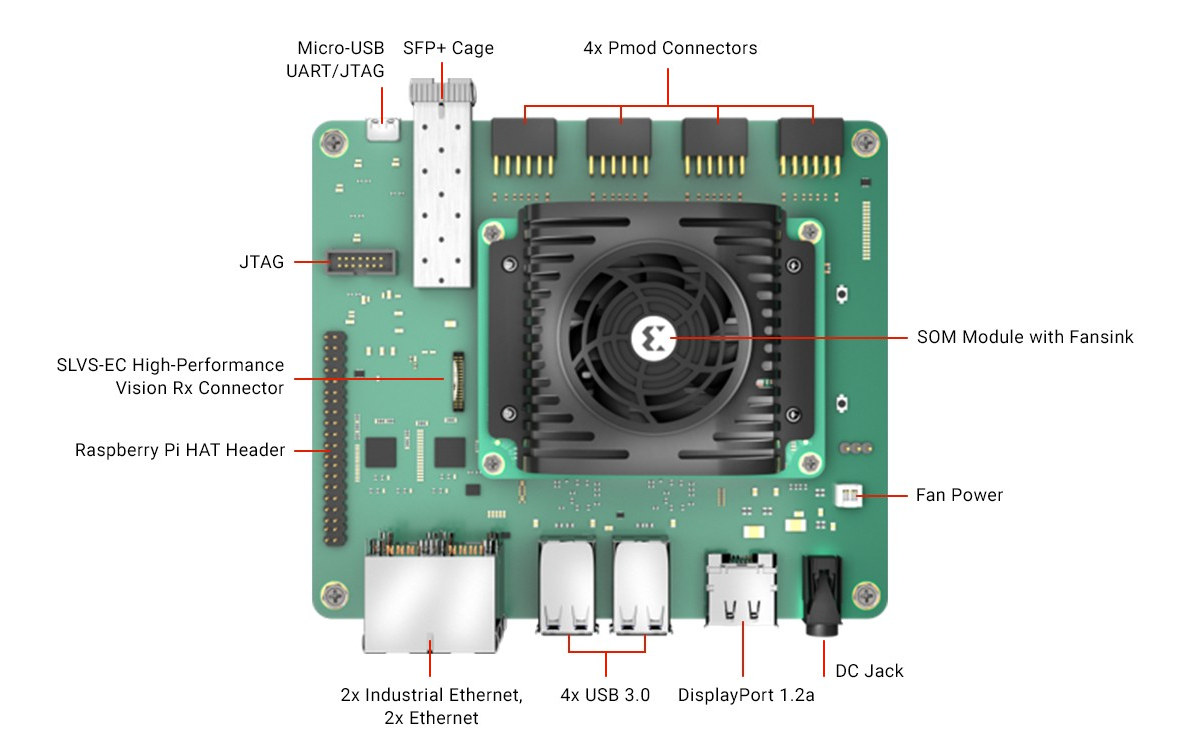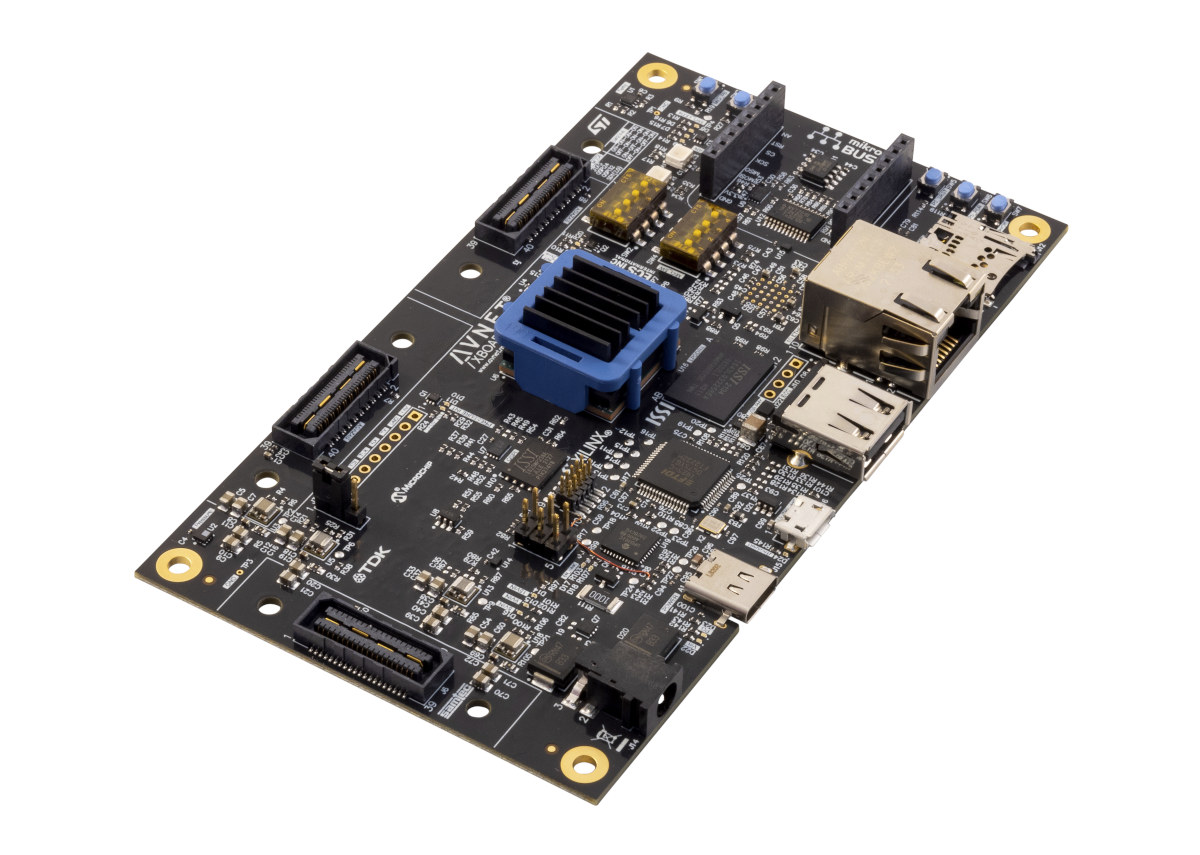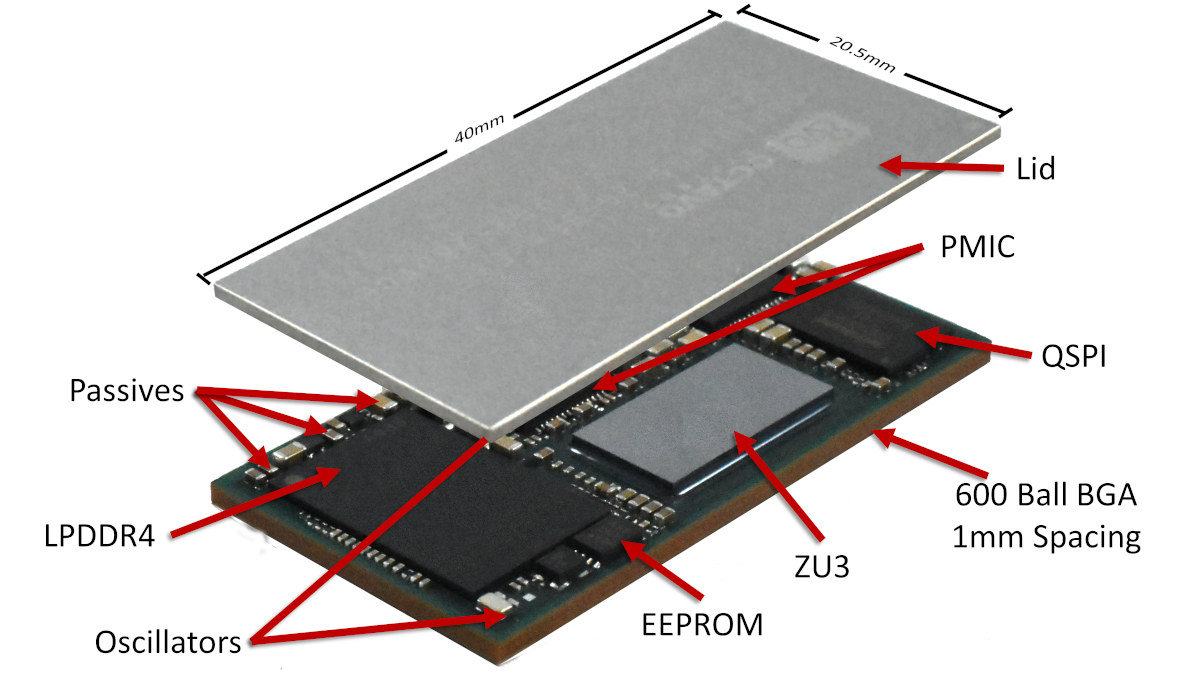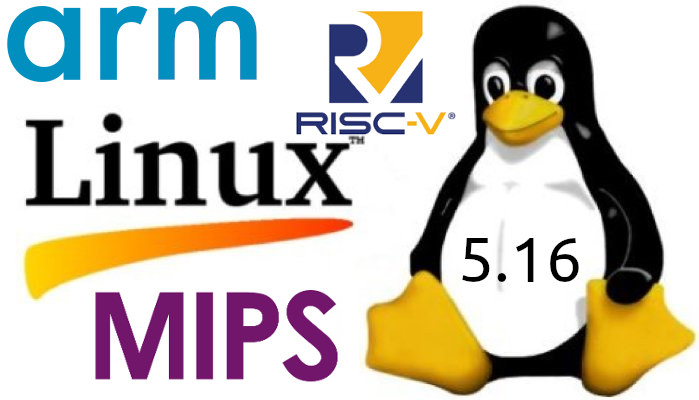MYIR Tech has launched the MYC-JX8MMA7 system-on-module combining an NXP i.MX 8M Mini quad-core Arm Cortex-A53 processor with an AMD Xilinx XC7A25T Artix-7 FPGA. The 82 x 45mm CPU module comes with 2GB LPDDR4, 8GB eMMC flash, and 32MB QSPI Flash for the Arm processor and 256MB DDR3 and 32MB QSPI Flash for FPGA. It exposes I/Os through an MXM 3.0 edge connector and can operate in the industrial temperature range (-40 to 85°C). MYC-JX8MMA7 CPU module specifications: SoC – NXP i.MX 8M Mini with quad-core Cortex-A53 processor @ up to 1.6 (industrial) or 1.8 GHz, Cortex-M4F real-time core @ 400 MHz, Vivante GC320 and Vivante GCNanoUltra 3D/2D GPUs, 1080p60 H.265, H.264, VP8, VP9 video decoder, 1080p60 H.264 & VP8 video encoder FPGA – AMD Xilinx Artix-7 XC7A25T-2CSG325 with 23,360 logic cells, 3x GTP System Memory and Storage SoC – 2GB LPDDR4, 8GB eMMC flash, and 32MB QSPI Flash FPGA […]
Zynq UltraScale+ SoM with up to 12GB RAM targets LiDAR applications
iWave Systems iW-RainboW-G30M is a system-on-module (SoM) based on AMD Xilinx Zynq UltraScale+ ZU4/ZU5/ZU7 FPGA MPSoC specially geared towards LiDAR applications for scientific and military applications. The module comes with up to 12GB of RAM, 4GB for the programmable logic (PL) and 8GB for the Arm Cortex-A53/R5-based Processing System (PS), two 240-pin high-density, high-speed connectors with 142 user I/Os, 16x GTH transceivers up to 16.3Gbps, and four GTR transceivers up to 6Gbps. iW-RainboW-G30M specifications: FPGA MPSoC – AMD Xilinx Zynq Ultrascale+ ZU4, ZU5, or ZU7 MPSoC with Processing System (PS) featuring 2x or 4x Arm Cortex-A53 core @ 1.5 GHz, two Cortex-R5 cores @ 600MHz, H.264/H.265 Video Encoder/Decoder (VCU), ARM Mali-400MP2 GPU @ 677MHz, and Programming Logic (PL)/FPGA with up to 504K Logic cells & 230K LUTs System Memory 4GB DDR4 64-bit RAM with ECC for PS (upgradeable up to 8GB) 2GB DDR4 16-bit RAM for PL (upgradeable up to […]
XRF16 Gen3 SOM features Xilinx Zynq UltraScale+ ZU49DR RFSoC with up to 6GHz bandwidth
We’ve written about Xilinx Zynq UltraScale+ MPSoCs that combine Arm Cortex-A53/R5 cores and Mali-400 GPU with Ultrascale FPGA fabric several times over the course of a few years. But AMD-Xilinx also offers the Zynq UltraScale+ RFSoC single-chip adaptable radio platforms that support up to 7.125GHz analog bandwidth. The topic came to my attention because of an upcoming ZU49DR SoM from iWave Systems that seems to be under development but also noticed Avnet had launched a solution last year with the XRF16 Gen3 SoM featuring the same third-generation Zynq Ultrascale+ ZU49DR RFSoC with 16 RF-ADC, 16 RF-DAC channels, and 6GHz RF bandwidth. Avnet XRF16 specifications: Main chip – Xilinx Zynq UltraScale+ Gen3 ZU49DR RFSoC with Quad-core Arm Cortex-A53 processing subsystem Dual-core Arm Cortex-R5F MPCore up to 533MHz 16x ADCs, 14-bit up to 2.5 GSPS 16x DACs, 14-bit up to 9.85 GSPS (10 GSPS Available) 1 GbE, PCIe Gen1/2, SATA, USB2/3 UltraScale+ […]
$349 AMD Kria KR260 Robotics Starter Kit takes on NVIDIA Jetson AGX Xavier devkit
AMD Xilinx Kria KR260 Robotics Starter Kit features the Kria K26 Zynq UltraScale+ XCK26 FPGA MPSoC system-on-module (SoM) introduced last year together with the Kria KV260 Vision AI Starter Kit. Designed as a development platform for robotics and industrial applications, the KR260 is said to deliver nearly 5x productivity gain, up to 8x better performance per watt and 3.5x lower latency compared to Nvidia Jetson AGX Xavier or Jetson Nano kits. We’ll have a better look at the details below. Kria KR260 Robotics Starter Kit specifications: SoM – Kria K26 module with: MPSoC – Xilinx Zynq Ultrascale+ custom-built XCK26 with quad-core Arm Cortex-A53 processor up to 1.5GHz, dual-core Arm Cortex-R5F real-time processor up to 600MHz, Mali-400 MP2 GPU up to 667MHz, 4Kp60 VPU, 26.6Mb On-Chip SRAM, 256K logic cells, 1,248 DSP slices, 144 Block RAM blocks, 64 UltraRAM blocks System Memory – 4GB 64-bit DDR4 (non-ECC) Storage – 512 Mbit […]
ZUBoard 1CG – A low-cost AMD Xilinx Zynq UltraScale+ ZU1CG MPSoC FPGA development board
Avnet ZUBoard 1CG is a development board featuring the new entry-level AMD Xilinx Zynq UltraScale+ ZU1CG dual-core Cortex-A53 MPSoC with 81K FPGA system logic cells, equipped with 1GB LPDDR4 RAM, as well as SYZYGY connectors and mikroBus expansion for Click boards. Priced at $159, the board may offer a good opportunity to get started with Zynq UltraScale+ MPSoC, as it’s quite cheaper than boards based on ZU3 devices such as Ultra96-V2 or MYD-CZU3EG. Avnet says the board is suitable for artificial intelligence, machine learning, embedded vision, embedded processing, and robotics applications. ZUBoard 1CG specifications: SoC – AMD/Xilinx ZU+ MPSoC ZU1CG with Dual Cortex-A53 APU @ up to 1.3 GHz and dual Cortex-R5 RPU @ up to 533 MHz 256KB On-chip Memory 81,900 FPGA Logic Cells System Memory – 1GB LPDDR4 with on-chip ECC Storage – 256Mbit QSPI flash, microSD card, both bootable Networking – 10/100/1000M Gigabit Ethernet RJ45 port USB […]
OSZU3 System-in-Package (SiP) combines AMD Xilinx Zynq UltraScale+ MPSoC with 2GB RAM, PMIC, passive components
Octavo Systems has collaborated with AMD Xilinx for the OSZU3 system-in-package (SiP) that combines Zynq UltraScale+ MPSoC ZU3 with up to 2GB RAM, power management circuitry, and other components into a compact (40×20.5mm) 600-ball BGA package. We’ve already written about other Octavo Systems SiPs in the past with solutions like OSD3358x (TI Sitara AM3358) and OSD32MP15x (STMicro STM32MP1), but the OSZU3 packs a much more powerful and flexible chip with the AMD Xilinx Zynq UltraScale+ MPSoC offering both Cortex-A53 & Cortex-R5F cores, Arm Mali-400 GPU, and FPGA fabric. Octavo Systems OSZU3 SiP specifications: SoC – AMD Xilinx Zynq UltraScale+ MPSoC ZU3 with CPU – 4x Arm Cortex-A53 up to 1.2GHz, 2x Arm Cortex-R5F up to 500MHz GPU – Arm Mali-400 FPGA 154K System Logic Cells 141K Flip-Flops 71K CLB LUTs 360 DSP Slices 7.6 Mb Block RAM System Memory – 2GB LPDDR4 Storage – 128MB SQPI, and 4K EEPROM (by […]
FOSDEM 2022 schedule with embedded Linux, IoT, automotive… sessions
While typically taking place in Brussels, Belgium, FOSDEM 2022 will take place online just like FOSDEM 2021 due to COVID-19 restrictions. The good news is that it means anybody can attend it live from anywhere in the world, and makes it more like “FOSDIM”, replacing European with International, in “Free and Open Source Developers’ European Meeting”. FOSDEM 2022 will take place on February 5-6 with 637 speakers, 718 events, and 103 tracks. I’ve made my own little virtual schedule below mostly with sessions from the Embedded, Mobile and Automotive devroom, but also other devrooms including “Computer Aided Modeling and Design”, “FOSS on Mobile Devices”, “Libre-Open VLSI and FPGA”, and others. Saturday, February 5, 2022 12:30 – 13:00 – Five mysteries in Embedded Linux by Josef Holzmayr Once you start out in embedded Linux, there is a lot to do. Some things are obvious, some less so. First and foremost, […]
Linux 5.16 Release – Main Changes, Arm, RISC-V and MIPS architectures
Linus Torvalds has just announced the release of Linux 5.16: Not a lot here since -rc8, which is not unexpected. We had that extra week due to the holidays, and it’s not like we had lots of last-minute things that needed to be sorted out. So this mainly contains some driver fixes (mainly networking and rdma), a cgroup credential use fix, a few core networking fixes, a couple of last-minute reverts, and some other random noise. The appended shortlog is so small that you might as well scroll through it. This obviously means that the merge window for 5.17 opens tomorrow, and I’m happy to say I already have several pending early pull requests. I wish I had even more, because this merge window is going to be somewhat painful due to unfortunate travel for family reasons. So I’ll be doing most of it on the road on a laptop […]


